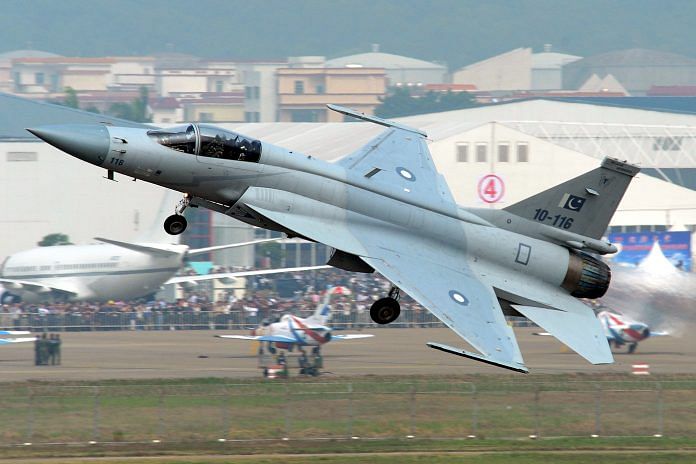New Delhi: Three unexploded H-4 glide-bombs, weighing 1,000 kg each, fired by Pakistan Air Force fighters on 27 February are still lying near the Line of Control (LoC) in the Rajouri sector of Jammu and Kashmir, but Indian forces have not been able to reach them because of intense shelling from the other side.
Top government sources told ThePrint that the PAF fired 11 bombs on 27 February, targeting Indian military installations in the Rajouri sector, besides five AMRAAM missiles fired by the F-16s targeting the Indian Air Force’s Sukhoi Su-30 MKI fighters.
“Three bombs are lying just near the LoC and within Indian territory. However, we have not been able to reach them because of intense shelling by the Pakistan Army,” a source said.
Sources said the bombs have fallen into a small gorge, so they’re difficult to reach.
What is an H-4 bomb?
The H-4 Stand-Off Weapon is a precision-guided glide bomb, somewhat similar to the SPICE-2000 used by the Indian Air Force to target the Jaish-e-Mohammed training camp in Balakot on 26 February.
The H-4, developed by South African firm Denel Dynamics, is now manufactured in Pakistan under licenced production. The Mirage aircraft in use with the PAF are capable of firing these bombs, while there were also plans to integrate them with the JF-17, a Chinese-Pakistani collaboration.
Also read: Indian Air Force dismisses Pakistani claims of shooting down a Sukhoi Su-30MKI
The Pakistani ploy
Pakistan had used a combination of Mirages, JF-17s and F-16s to carry out the unsuccessful raid.
Around 9.30 am on 27 February, the Indian air defence system, on full alert, noticed a build-up of about 25 PAF aircraft across the LoC.
At the time, only four Indian aircraft were on Combat Air Patrol (CAP) in the Kashmir sector — two Mirage-2000s to the north of the Pir Panjal range and two Su-30s to the south.
One set of Pakistani fighter aircraft engaged with the Mirages in the north while another engaged with the Sukhois in the south.
In between, a third set of fighters tried to target the military installations.
“At no point of time did the Pakistani fighters cross into the Indian territory. The chatter picked up clearly showed multiple instructions to not cross the LoC and fire from within their air space,” a source said.
Seeing the approaching fighters, the IAF control room in Punjab ordered more fighters to be scrambled, and a total of seven MiG-21 Bison aircraft took off from the Srinagar and Awantipur air bases, including the one flown by Wing Commander Abhinandan Varthaman.
Since the MiGs climbed in the shadow of the Pir Panjal range, Pakistan’s airborne early warning and control (AWAC) system failed to detect them. Their sudden appearance left the Pakistani fighters taken aback.
“They dropped bombs in a hurry and tried to get away. This is the moment when Wing Commander Abhinandan crossed about 8 km inside Pakistan in pursuit of a PAF fighter,” a source said.
Why the bombs did not hit the targets
It was pure luck and the sudden appearance of the MiG-21s that worked in India’s favour.
Radio chatter picked up by the Indian security forces gives an insight into what the PAF was planning — it was clear they had intended to target the military installations and also not cross the LoC.
While the air battle was on, the main concern of the PAF was the pilot of an F-16 reporting oxygen failure, sources said.
“Contrary to what Pakistan claims, the bombs had specifically targeted military installations. For example, one bomb hit the trees within a brigade compound and exploded. Had those trees not been there, the brigade headquarters would have been hit,” an Indian Army source said.
Also read: These are the 3 locations in Pakistan that were bombed by Indian Air Force




Enough hue and cry raised within our own country about this
We should dissuade ourselves commenting and criticising about the failure fall out or success of out Indian air force
We should always believe that what was done by IAF was right and we must be proud of it’s agile activity rather than what was done in air strike by our force
Dear friends unexploded bombs lying inside our territory us enough proof to understand the nefarious designs if Pakistan which was our territory but they failed to appreciate and understand the fact
So my request be proud of our forces donot criticise as enough damage done to our own
Shameful act to suspect our own
It seems India attacked Pakistan without any plan for the next step………….seems like a political stunt to win elections rather than a serious war effort !!!!
And still some would argue that” a stable and prosperous Pakistan is in India’s interests” .
By the grace of God, we have not had to fight a two and a half front war. However, we have come too close for comfort, in all three theatres. Great wisdom in lowering the flame of contestation.
Please send these bombs to leaders who want proof or better make them sit near to these as a proof.